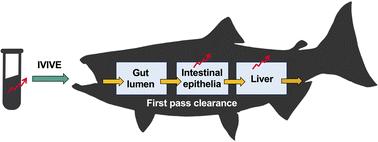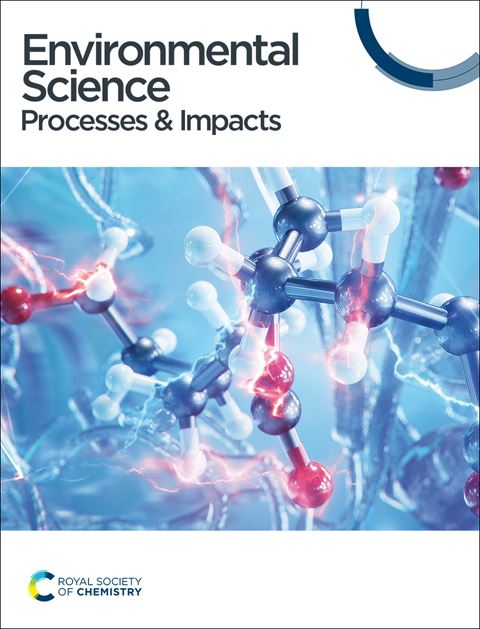An amended in vitro–in vivo extrapolation model that accounts for first pass clearance effects on chemical bioaccumulation in fish†
IF 4.3
3区 环境科学与生态学
Q1 CHEMISTRY, ANALYTICAL
引用次数: 0
Abstract
Measured rates of in vitro intrinsic clearance for fish may be extrapolated to the whole animal as a means of estimating a whole-body biotransformation rate constant (kB; d-1). This estimate of kB can then be used as an input to existing bioaccumulation prediction models. Most in vitro-in vivo extrapolation/bioaccumulation (IVIVE/B) modeling efforts to date have focused on predicting the chemical bioconcentration in fish (aqueous only exposure), with less attention paid to dietary exposures. Following dietary uptake, biotransformation in the gut lumen, intestinal epithelia, and liver can reduce chemical accumulation; however, current IVIVE/B models do not consider these first pass clearance effects on dietary uptake. Here we present an amended IVIVE/B model that accounts for first pass clearance. The model is then used to examine how biotransformation in the liver and intestinal epithelia (alone or combined) may impact chemical accumulation that occurs during dietary exposure. First pass clearance by the liver can greatly reduce dietary uptake of contaminants, but these effects are only apparent at rapid rates of in vitro biotransformation (first order depletion rate constant kDEP ≥ 10 h-1). The impact of first pass clearance becomes more pronounced when biotransformation in the intestinal epithelia is included in the model. Modelled results suggest that biotransformation in the liver and intestinal epithelia cannot entirely explain reduced dietary uptake reported in several in vivo bioaccumulation tests. This unexplained reduction in dietary uptake is attributed to chemical degradation in the gut lumen. These findings underscore the need for research to directly investigate luminal biotransformation in fish.

一个修正的体外体内外推模型,该模型解释了鱼体内化学生物积累的首次通过清除效应
鱼体外固有清除率的测量率可以外推到整个动物,作为估计全身生物转化率常数(kB;d ? 1)。kB的估计值可以作为现有生物积累预测模型的输入。迄今为止,大多数体外/体内外推/生物积累(IVIVE/B)建模工作都集中在预测鱼体内的化学生物浓度(仅在水中暴露),而对饮食暴露的关注较少。在饮食摄取后,肠腔、肠上皮和肝脏中的生物转化可以减少化学物质的积累;然而,目前的IVIVE/B模型并未考虑这些首次通过清除对饮食摄取的影响。在这里,我们提出了一个修正的IVIVE/B模型,该模型考虑了首次通过许可。然后使用该模型来检查肝脏和肠上皮(单独或联合)中的生物转化如何影响饮食暴露期间发生的化学物质积累。肝脏的一过清除可以大大减少污染物的膳食摄取,但这些影响仅在体外生物转化的快速速率下才明显(一级消耗速率常数kDEP≥10 h?1)。当肠上皮的生物转化被包括在模型中时,首次通过清除的影响变得更加明显。模拟结果表明,肝脏和肠上皮的生物转化不能完全解释几项体内生物积累试验中报告的饮食摄取减少。这种无法解释的饮食摄取减少归因于肠道内的化学降解。这些发现强调了直接研究鱼类肠道生物转化的必要性。
本文章由计算机程序翻译,如有差异,请以英文原文为准。
求助全文
约1分钟内获得全文
求助全文
来源期刊

Environmental Science: Processes & Impacts
CHEMISTRY, ANALYTICAL-ENVIRONMENTAL SCIENCES
CiteScore
9.50
自引率
3.60%
发文量
202
审稿时长
1 months
期刊介绍:
Environmental Science: Processes & Impacts publishes high quality papers in all areas of the environmental chemical sciences, including chemistry of the air, water, soil and sediment. We welcome studies on the environmental fate and effects of anthropogenic and naturally occurring contaminants, both chemical and microbiological, as well as related natural element cycling processes.
 求助内容:
求助内容: 应助结果提醒方式:
应助结果提醒方式:


